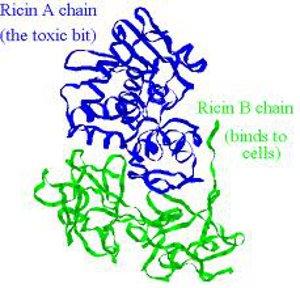BioterrorismHow the bioweapon ricin kills
Ricin is one of the deadliest plant based poisons in the world, and what makes it especially dangerous is that it comes from the humble castor oil bean and is available in many health food shops or online; scientists discover the protein that controls how ricin kills

Blocking Gpr107 prevents the Ricin B chain from binding to cells // Source: sodahead.com
A key protein that controls how the deadly plant poison and bioweapon ricin kills, has finally been identified by researchers at the Institute of Molecular Biotechnology in Vienna, Austria. The discovery was made using a technology that combines stem cell biology and modern screening methods, and reported Friday, 2 December 2011, in the scientific journal Cell Stem Cell.
News spread in August this year that al Quaeda was producing bombs containing the poison ricin to attack shopping centers, airports, or train stations. Since the First World War, ricin has had a gruesome reputation as a bioweapon, and is one of the deadliest plant based poisons in the world.
An IDW release reports that even a tiny amount can kill a person within two to three days after getting into the bloodstream. The poison comes from the humble castor oil bean, available in many health food shops or online.
How the poison works
Castor oil is a powerful laxative, used medicinally for centuries, but the raw beans also contain small amounts of the poison ricin. So far no antidote is available. Now, however, Ulrich Elling, a scientist on the research team led by Professor Josef Penninger at the Institute for Molecular Biotechnology (IMBA) of the Austrian Academy of Sciences in Vienna, has identified a protein molecule called Gpr107. This protein in the targeted cells is essential for the deadly effect of ricin. In other words, cells which lack Gpr107 are immune to the poison.
Ulrich Elling is optimistic, saying “Our research suggests that a specific antidote could now be developed by making a small molecule to block the Gpr107 protein.”
Screening of the entire mammal genome
The researchers at IMBA were able to find in just a few weeks what others have been trying to find for decades.
Their rapid success was made possible by a new method of genetic research developed largely by Ulrich Elling and Penninger. With this new method, an entire mammal genome can be screened for mutations within a reasonable time frame.
Until now, screening methods for mice, rats, and other mammals have focused on finding one single mutation. This was done using a technique called RNA interference or by breeding a suitable ‘knock-out mouse’ to study the effect of removing a single gene. RNA interference, however, does not always work, and breeding a knock-out mouse takes years and considerable effort.
The release notes that this is why Penninger sees this powerful technology as a revolution in biomedicine. “We’ve now succeeded in combining the genetics of yeast, which has a single chromosome set that allows instant gene mutation, with stem cell biology”, he says. “For decades researchers have been looking for a system in mammals which would allow scientists to reconstruct millions of gene mutations simultaneously. We have solved the puzzle and even broke a paradigm in biology — we managed to make stable mouse stem cells with a single set of chromosomes and developed novel tools to use such stem cells to rapidly check virtually all genes at the same time for a specific function.”
This new technology helped Elling in unraveling the toxic effect of ricin. He tested the poison in thousands of different mutations of mouse stem cells, and discovered that forty-nine different genetic mutations were present in one single protein, Gpr107. Obviously, a mutation in this protein saved the cells.
Combination with stem cell research
The potential in this discovery becomes even clearer in light of stem cells’ ability to transform into any cell in the human body. Penninger is excited. “The possible uses of this discovery are endless. They range from fundamental issues, like which genes are necessary for the proper function of a heart muscle cell, to concrete applications as we have done in the case of ricin toxicity.”
Penninger’s team is already working on its next projects, including studies on how tumor cells acquire resistance to chemotherapy, a key issue in the development of cancer, and how nerve cells can regenerate, to offer hope in cases of paraplegia.
